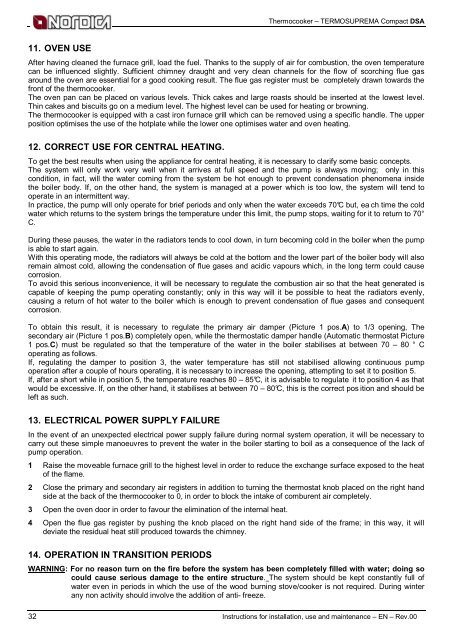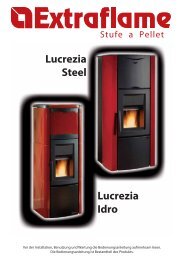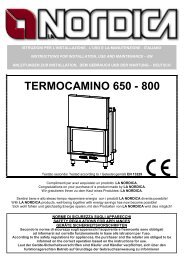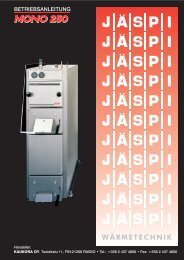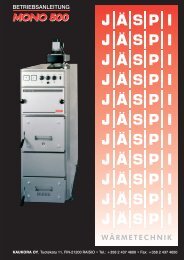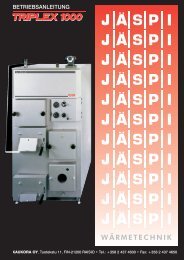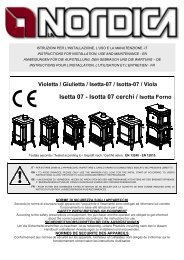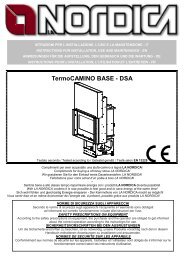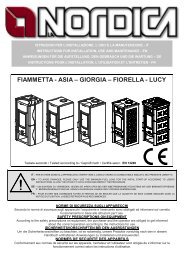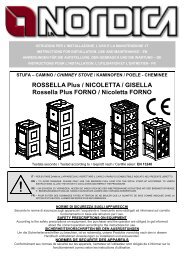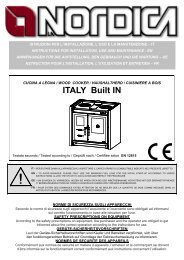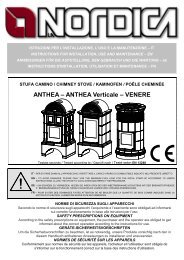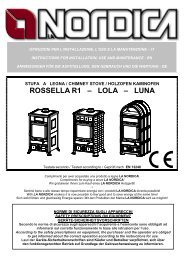TERMOSUPREMA Compact - DSA
TERMOSUPREMA Compact - DSA
TERMOSUPREMA Compact - DSA
Create successful ePaper yourself
Turn your PDF publications into a flip-book with our unique Google optimized e-Paper software.
Thermocooker – <strong>TERMOSUPREMA</strong> <strong>Compact</strong> <strong>DSA</strong><br />
11. OVEN USE<br />
After having cleaned the furnace grill, load the fuel. Thanks to the supply of air for combustion, the oven temperature<br />
can be influenced slightly. Sufficient chimney draught and very clean channels for the flow of scorching flue gas<br />
around the oven are essential for a good cooking result. The flue gas register must be completely drawn towards the<br />
front of the thermocooker.<br />
The oven pan can be placed on various levels. Thick cakes and large roasts should be inserted at the lowest level.<br />
Thin cakes and biscuits go on a medium level. The highest level can be used for heating or browning.<br />
The thermocooker is equipped with a cast iron furnace grill which can be removed using a specific handle. The upper<br />
position optimises the use of the hotplate while the lower one optimises water and oven heating.<br />
12. CORRECT USE FOR CENTRAL HEATING.<br />
To get the best results when using the appliance for central heating, it is necessary to clarify some basic concepts.<br />
The system will only work very well when it arrives at full speed and the pump is always moving; only in this<br />
condition, in fact, will the water coming from the system be hot enough to prevent condensation phenomena inside<br />
the boiler body. If, on the other hand, the system is managed at a power which is too low, the system will tend to<br />
operate in an intermittent way.<br />
In practice, the pump will only operate for brief periods and only when the water exceeds 70°C but, ea ch time the cold<br />
water which returns to the system brings the temperature under this limit, the pump stops, waiting for it to return to 70°<br />
C.<br />
During these pauses, the water in the radiators tends to cool down, in turn becoming cold in the boiler when the pump<br />
is able to start again.<br />
With this operating mode, the radiators will always be cold at the bottom and the lower part of the boiler body will also<br />
remain almost cold, allowing the condensation of flue gases and acidic vapours which, in the long term could cause<br />
corrosion.<br />
To avoid this serious inconvenience, it will be necessary to regulate the combustion air so that the heat generated is<br />
capable of keeping the pump operating constantly; only in this way will it be possible to heat the radiators evenly,<br />
causing a return of hot water to the boiler which is enough to prevent condensation of flue gases and consequent<br />
corrosion.<br />
To obtain this result, it is necessary to regulate the primary air damper (Picture 1 pos.A) to 1/3 opening, The<br />
secondary air (Picture 1 pos.B) completely open, while the thermostatic damper handle (Automatic thermostat Picture<br />
1 pos.C) must be regulated so that the temperature of the water in the boiler stabilises at between 70 – 80 ° C<br />
operating as follows.<br />
If, regulating the damper to position 3, the water temperature has still not stabilised allowing continuous pump<br />
operation after a couple of hours operating, it is necessary to increase the opening, attempting to set it to position 5.<br />
If, after a short while in position 5, the temperature reaches 80 – 85°C, it is advisable to regulate it to position 4 as that<br />
would be excessive. If, on the other hand, it stabilises at between 70 – 80°C, this is the correct pos ition and should be<br />
left as such.<br />
13. ELECTRICAL POWER SUPPLY FAILURE<br />
In the event of an unexpected electrical power supply failure during normal system operation, it will be necessary to<br />
carry out these simple manoeuvres to prevent the water in the boiler starting to boil as a consequence of the lack of<br />
pump operation.<br />
1 Raise the moveable furnace grill to the highest level in order to reduce the exchange surface exposed to the heat<br />
of the flame.<br />
2 Close the primary and secondary air registers in addition to turning the thermostat knob placed on the right hand<br />
side at the back of the thermocooker to 0, in order to block the intake of comburent air completely.<br />
3 Open the oven door in order to favour the elimination of the internal heat.<br />
4 Open the flue gas register by pushing the knob placed on the right hand side of the frame; in this way, it will<br />
deviate the residual heat still produced towards the chimney.<br />
14. OPERATION IN TRANSITION PERIODS<br />
WARNING: For no reason turn on the fire before the system has been completely filled with water; doing so<br />
could cause serious damage to the entire structure. The system should be kept constantly full of<br />
water even in periods in which the use of the wood burning stove/cooker is not required. During winter<br />
any non activity should involve the addition of anti- freeze.<br />
32 Instructions for installation, use and maintenance – EN – Rev.00


